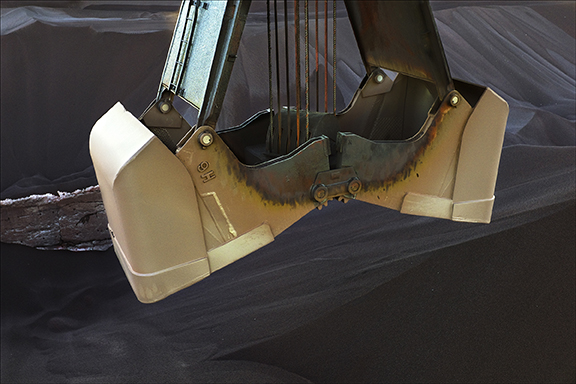
CARLOS DIAZ, ROUGE SERIES: CLAM SHELL BUCKET – 2012-14 C PRINT 21 X 30″
The David Klein Gallery in Detroit opened a retrospective exhibition of work by the photographer Carlos Diaz, May 13, 2017. Spaces & Spectacle covers four themes of work dating back to the early 1980’s. Diaz, a Professor of Photography at Center for Creative Studies, has taught and influenced several generations of students in the art of photography over the course of 35 years.
It has been at least a couple of generations since photographers were loading 35mm film into their single lens reflex cameras on a daily basis, providing themselves with the means to record images. The commercial photographers were using mid-range Hasselblad, Cannon, and Nikon that recorded on 2.25 x 2.25 rolls of film, a format that provided the resolution for high-quality print work. All of this changed in the mid-1990’s when digital photography came of age, founded in part by the NASA space program. Diaz had been using film to capture his fine art images, sometimes referred to today as analog versus the digital world of solid-state CCD image sensor chips. In this exhibition, we see a variety of formats Diaz has used to capture and print his fine art photography.
Christine Schefman, Gallery Director says, “The photographs and collages reflect Diaz’s continued interest in the American Industrial Revolution, which gave birth to the working class, and the American amusement industry which was born out of the Revolution.”
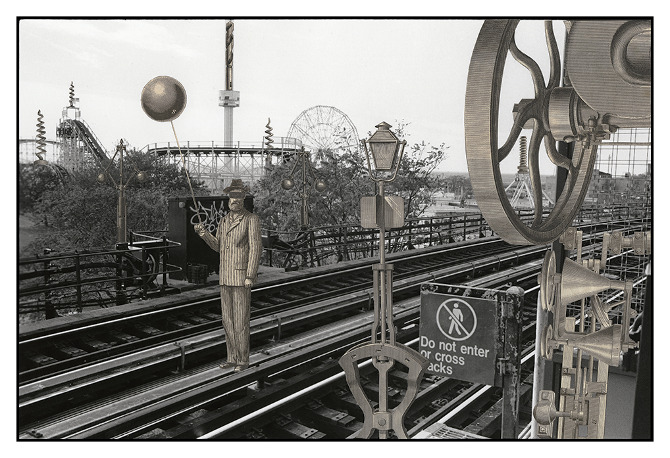
CARLOS DIAZ, INVENTED LANDSCAPES OF CONEY ISLAND – 2006 COLLAGE: GELATIN SILVER PRINT & VINTAGE STEEL PLATE WITH WOOD BLOCK ENGRAVINGS 11 X 14″
The collage series Invented Landscapes of Diaz’s work perhaps draws on experience doing mechanical drawing before he started his formal art studies. He went on to complete his BFA from Center for Creative Studies in Detroit and an MFA from the University of Michigan School of Art. The photographic collages are images of the industrial based Coney Island amusement park that became a backdrop for hand-cut images from old patent manuals, allowing Diaz to create what he has described in his statement, “The Invented Landscapes images and the Coney Island environment provides a space to merge both metaphorically and literally, the machines of the industrial revolution and the amusement park landscape. They are the fusion of the functional forms of labor and the fun of the fantasy of the carnival.” The change in tonality allows the viewer to see the added elements.
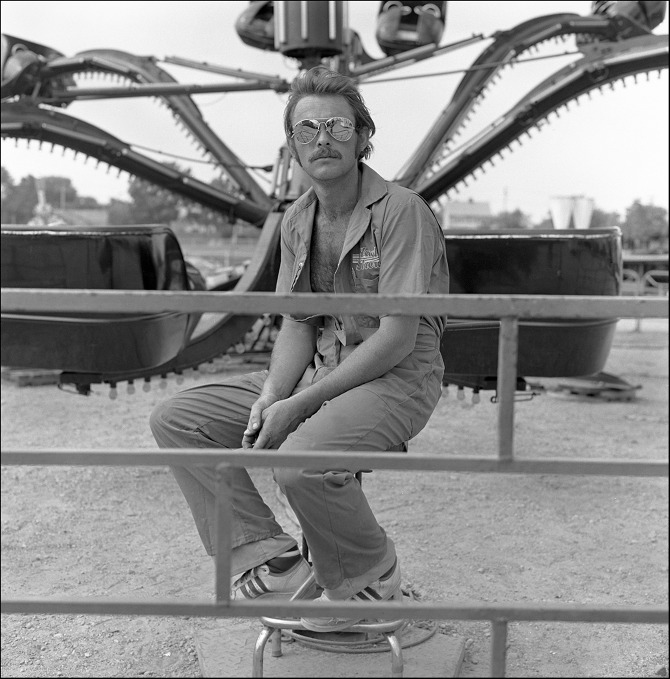
CARLOS DIAZ, WADE CARNIVAL SHOWS: OCTOPUS RIDE ATTENDANT – 1980-83 ARCHIVAL INKJET PRINT 36 X 36″
In these early 2 x 2 mid-range photographs, created in 1980 while Diaz was still in Ann Arbor, he selects and poses carnival ride attendants for a straight-forward full-bodied portrait. It is back then that it becomes evident that Carlos Diaz has a psychological preference for formal balance in many of his compositions. In the work, Octopus Ride Attendant, Diaz spends the time to center the figure and create an equal amount of space in all directions, either in the compositional set-up or in the printing (described as an archival inkjet print, meaning the negative was scanned and printed using an inkjet printer.) This element does not appear in the Invented Landscape work but dominates most of his other work. To illustrate, when you visit his web site, his image and the text are all centered on the page. I recommend visiting the web site where you can view his entire body of work. He says, “In one form or fashion, photography for me has always provided an opportunity to attempt to understand other people and their circumstances.”

Mary’s Garden, Beyond Borders, 2010, C print. 23 x 30 inches
There is one photograph in the exhibition, Mary’s Garden that comes from his Beyond Borders series where he documents the front yards of many homes in Southwest Detroit. This photograph is another good example of creating this approach to a formal sense of balance and sensibility. The balance comes from this vertical chimney centered in the composition and an even amount of design weight to the large home on the right and the Madonna flower arrangement on the left, not to mention the nice halo of foliage around the parked truck, where a formality of color balance comes into play as well.
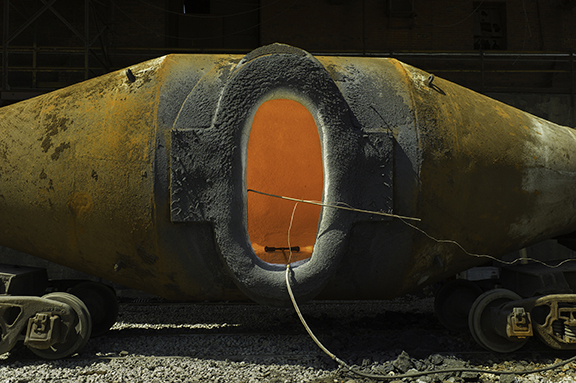
CARLOS DIAZ ROUGE SERIES: TORPEDO CAR – 2012-14 C PRINT 21 X 30″
These photographs from the Rouge Series look like full-frame color prints from 35mm film and printed as a C-Print. The term C-print stands for Chromogenic color prints. These are full-color photographic prints made using traditional chemicals and processes. It seems natural that Carlos Diaz would be interested in the Ford Rouge Complex, in that he grew up in Pontiac, Michigan and had a close relationship with the auto industry. Many of his family members work for the auto companies, and Diaz recalls his experience when he first saw the Diego Rivera murals at the Detroit Institute of Arts. He says, “When I saw the Diego Rivera Murals, my view of the automotive worker’s role and the understanding of the realities of automotive production shifted as I began to see modernists painters like Charles Sheeler, who depicted the Rouge and industry as a means that would save mankind.” Here, in the work Torpedo Car, Diaz centers his image, providing more evidence of this preference to address the concept of formality in composition.
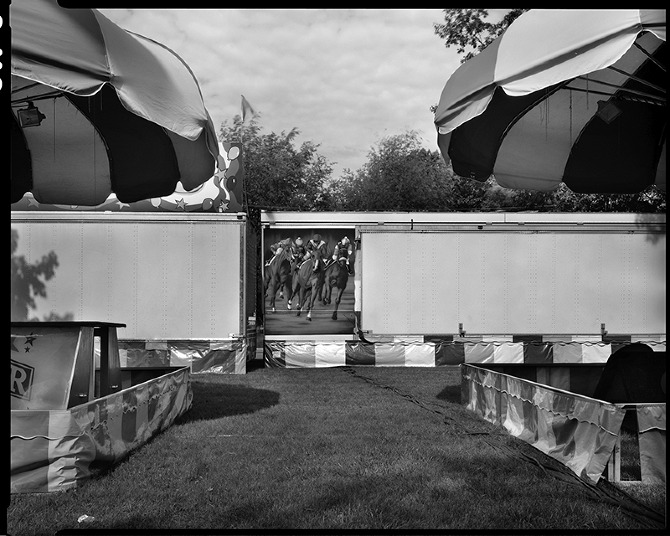
CARLOS DIAZ, CARNIVAL MIDWAY: HORSE RACE MURAL – 2008 ARCHIVAL INKJET PRINT 24 X 30″
Carlos Diaz remains interested in the life surrounding carnivals, not just the people, but also the structures, the culture and perhaps the nostalgia. In the 2008 print Horse Race Mural, part of the American Carnival Midway series, the work is formally composed and celebrates the photographic image center stage. We see how the umbrellas enter into the composition, almost identical on each side; More like Ansel Adams, than Henri Cartier-Bresson.
David Klein Gallery until June 10, 2017
